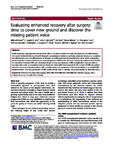Evaluating enhanced recovery after surgery: time to cover new ground and discover the missing patient voice
| dc.contributor.author | Nunns, M | |
| dc.contributor.author | John, JB | |
| dc.contributor.author | McGrath, JS | |
| dc.contributor.author | Shaw, L | |
| dc.contributor.author | Briscoe, S | |
| dc.contributor.author | Thompson Coon, J | |
| dc.contributor.author | Hemsley, A | |
| dc.contributor.author | Lovegrove, Chris | |
| dc.contributor.author | Thomas, D | |
| dc.contributor.author | Mythen, MG | |
| dc.contributor.author | Anderson, R | |
| dc.date.accessioned | 2022-02-17T13:42:30Z | |
| dc.date.issued | 2020-12 | |
| dc.identifier.issn | 2047-0525 | |
| dc.identifier.issn | 2047-0525 | |
| dc.identifier.other | 27 | |
| dc.identifier.uri | http://hdl.handle.net/10026.1/18809 | |
| dc.description.abstract |
<jats:title>Abstract</jats:title><jats:p>Multicomponent peri-operative interventions offer to accelerate patient recovery and improve cost-effectiveness. The recent National Institute of Health Research-commissioned evidence synthesis review by Nunns et al. considers the effectiveness and cost-effectiveness of all types of multicomponent interventions for older adults undergoing elective inpatient surgery. Enhanced recovery programmes (ERPs) were the most commonly evaluated intervention. An association between ERPs and decreased length of stay was observed, whilst complication rates and time to recovery were static or sometimes reduced. Important areas which lack research in the context of ERPs are patient-reported outcome measures, patients with complex needs and assessment of factors pertaining to successful ERP implementation. The next generation of ERP studies should seek to develop our understanding in these key areas.</jats:p> | |
| dc.format.extent | 27- | |
| dc.format.medium | Electronic-eCollection | |
| dc.language | en | |
| dc.language.iso | en | |
| dc.publisher | BioMed Central | |
| dc.subject | Complications | |
| dc.subject | ERAS | |
| dc.subject | ERP | |
| dc.subject | Elderly | |
| dc.subject | Elective surgery | |
| dc.subject | Enhanced recovery after surgery | |
| dc.subject | Meta-analysis | |
| dc.subject | Prehabilitation | |
| dc.subject | Recovery | |
| dc.subject | Rehabilitation | |
| dc.title | Evaluating enhanced recovery after surgery: time to cover new ground and discover the missing patient voice | |
| dc.type | journal-article | |
| dc.type | Editorial | |
| plymouth.author-url | https://www.ncbi.nlm.nih.gov/pubmed/32944227 | |
| plymouth.issue | 1 | |
| plymouth.volume | 9 | |
| plymouth.publication-status | Published | |
| plymouth.journal | Perioperative Medicine | |
| dc.identifier.doi | 10.1186/s13741-020-00157-1 | |
| plymouth.organisational-group | /Plymouth | |
| plymouth.organisational-group | /Plymouth/Faculty of Health | |
| plymouth.organisational-group | /Plymouth/Faculty of Health/School of Health Professions | |
| plymouth.organisational-group | /Plymouth/Research Groups | |
| plymouth.organisational-group | /Plymouth/Research Groups/FoH - Applied Parkinson's Research | |
| plymouth.organisational-group | /Plymouth/Users by role | |
| plymouth.organisational-group | /Plymouth/Users by role/Academics | |
| plymouth.organisational-group | /Plymouth/Users by role/Researchers in ResearchFish submission | |
| dc.publisher.place | England | |
| dcterms.dateAccepted | 2020-08-24 | |
| dc.rights.embargodate | 2022-2-18 | |
| dc.identifier.eissn | 2047-0525 | |
| dc.rights.embargoperiod | Not known | |
| rioxxterms.versionofrecord | 10.1186/s13741-020-00157-1 | |
| rioxxterms.licenseref.uri | http://www.rioxx.net/licenses/all-rights-reserved | |
| rioxxterms.licenseref.startdate | 2020-12 | |
| rioxxterms.type | Journal Article/Review |


